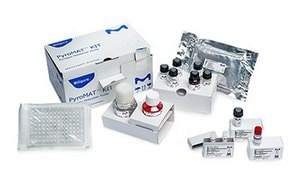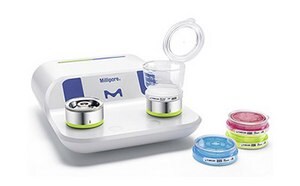Sterility Testing
Sterility testing is a GMP microbiology testing requirement used to confirm sterile products do not contain viable microorganisms before release and patient administration. Sterility testing methods must be as accurate as possible, due to their importance for medical devices, pharmaceutical products, and formulations, tissue materials, and other products that claim to be sterile or free from viable microorganisms.
Featured Categories
Laboratory instruments and consumables for sterility testing in microbiological quality control: Sterility test media, pumps, hardware and accessories.
Ensure safety: Pyrogen testing is vital for pharmaceuticals, devices. Monocyte Activation Test (MAT) detects endotoxin, non-endotoxin pyrogens.
Speed up your time-to-result with rapid microbial testing using our complete membrane filtration systems; used in bioburden testing, food and beverage analysis, and cannabis microbiology testing.
Sterility testing procedures are applied to products in many industries, including food and beverage manufacturers, but the main industries are the pharmaceutical and medical sectors where the sterility testing of the products remains a vital and routine task for microbiologists.
- Pharmaceutical Sterility Testing Methods
- Sterility Testing Methods for Medical Devices
- Sterility Testing Workflow
Pharmaceutical Sterility Testing Methods
Compendial methods for the sterility testing of pharmaceutical products requires samples to be cultured in two separate media. Two different types of culture media are used in sterility testing to promote the growth of residual anaerobes, as well as aerobes and fungi. Fluid thioglycolate medium (FTM) is typically used to culture anaerobic and some aerobic bacteria, while soybean casein digest medium (SCDM) is typically used to culture fungi and aerobic bacteria. Samples are incubated for 14 days at 32.5 °C and 22.5 °C respectively, prior to examination. Any turbidity in the culture media may indicate growth and must be investigated. There are two recommended methods of sterility testing for pharmaceuticals: membrane filtration and direct inoculation.
Membrane Filtration Sterility Testing
Membrane filtration sterility testing is the regulatory method of choice for filterable pharmaceutical products, as cited in the USP <71>, EU Pharmacopoeia < 2.6.1>, and JP Pharmacopoeia <4.06>. Samples are passed through a 0.45 µm membrane filter in a filtration canister and culture medium is added for incubation. This method of sterility testing can provide increased sensitivity in comparison to other methods as the whole sample, or a composite sample is passed through a single filter. Filtration also provides an opportunity to rinse away components in the sample that may cause turbidity or inhibit growth, such as antibiotics or preservatives.
Direct Inoculation Sterility Testing
In direct inoculation, a small volume of sample is removed aseptically from the sample unit and inoculated directly into a suitable volume of growth medium before incubation. While simple, this method of testing can have some significant limitations. Only small volumes of product can be inoculated into the culture medium, limiting the test sensitivity. If the sample appears cloudy or turbid after inoculation, it can be challenging to detect turbidity from microbial growth at the end of the incubation period. Additionally, if the product has antimicrobial properties, the sample must be neutralized so that microbial growth is not inhibited.
Sterility Testing Methods for Medical Devices
Direct transfer sterility testing is recommended for the sterility testing of medical devices. The device to be tested is in direct contact with the test media throughout the incubation period, during which any microorganism in or on the device will grow and proliferate. Furthermore, product flush sterility testing is preferred for products with hollow tubes, such as transfusion and infusion assemblies, where the fluid pathway is labeled as sterile. The product lumen is flushed with a rinsing fluid, the elute is membrane filtered and is placed in a suitable media for incubation.
Sterility Testing Workflow
1. Test Preparation—Place the membrane filtration device tubing into the pump
2. Filter Prewetting—Prewet the membrane filtration device to optimize filtration and minimize product binding to the filter.
3. Sample Filtration—Filter an equal amount of product into both canisters. Microorganisms are retained by a 0.45 µm pore size filter.
4. Rinsing—All inhibiting compounds are rinsed using a suitable rinse solution(s).
5. Culture Media Filling—Membrane filtration devices are filled with TSB and FTM sterile culture media.
6. Incubation Time—14 days.
7. Final Test Results—Visual turbidity /no turbidity check.
Visit our document search for data sheets, certificates and technical documentation.
Related Articles
- The user-friendly Steritest® Symbio pumps and accessories are designed for easy and reliable sterility testing. The system improves your workflow and maximizes safety, confidence, and convenience.
- Sterility testing is one of the most crucial steps in pharmaceutical product release. Regulatory-compliant membrane filtration sterility testing devices ensure the safety of pharmaceutical products.
- Our sterility testing media and fluids are formulated and tested to meet EU, US, and JP pharmacopeia regulations, and are supplied with full certification containing pH, sterility, and growth promotion information.
- Direct inoculation of culture media is the method of choice for sterility testing of non-filterable samples. Select from our range of sterility testing media including soybean casein digest medium (TSB), and Fluid Thioglycollate medium (FTM standard and clear).
- Sterile Isopropyl Myristate (IPM) enhances filterability for sterility testing of viscous products using the Steritest® NEO device.
- See All (8)
Related Protocols
- Cell culture protocol for testing cell lines for bacterial and fungal contamination. Free ECACC handbook download.
Find More Articles and Protocols
How Can We Help
In case of any questions, please submit a customer support request
or talk to our customer service team:
Email custserv@sial.com
or call +1 (800) 244-1173
Additional Support
- Chromatogram Search
Use the Chromatogram Search to identify unknown compounds in your sample.
- Calculators & Apps
Web Toolbox - science research tools and resources for analytical chemistry, life science, chemical synthesis and materials science.
- Customer Support Request
Customer support including help with orders, products, accounts, and website technical issues.
- FAQ
Explore our Frequently Asked Questions for answers to commonly asked questions about our products and services.
To continue reading please sign in or create an account.
Don't Have An Account?



